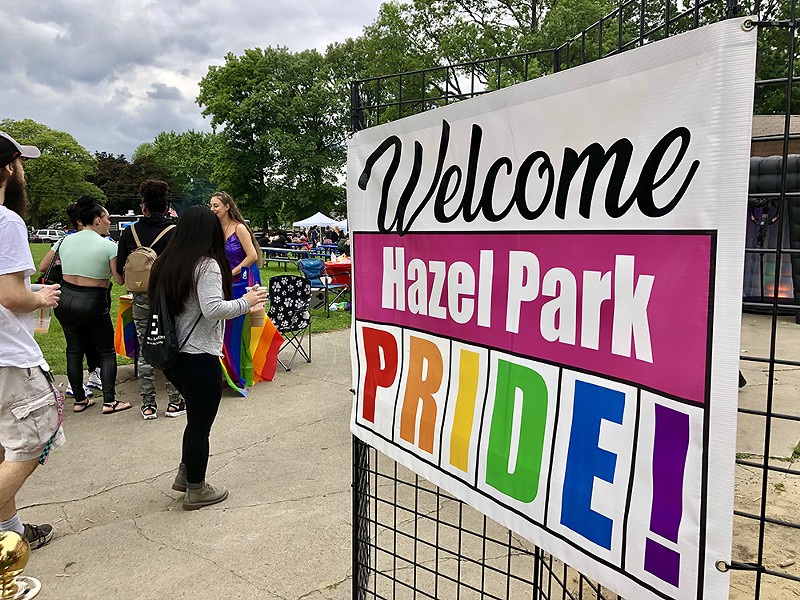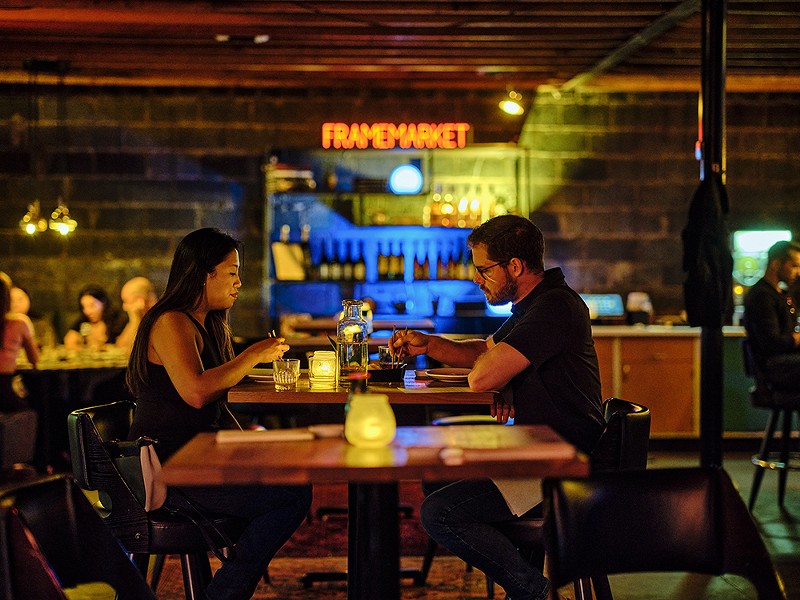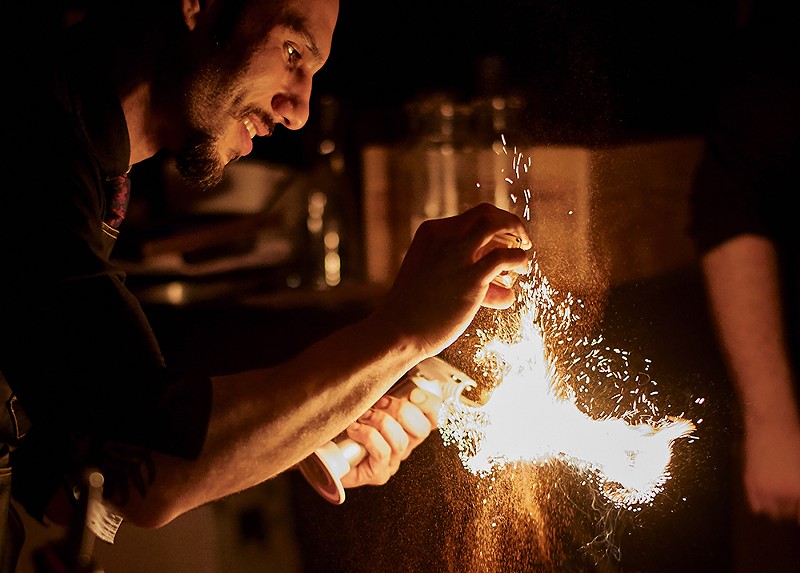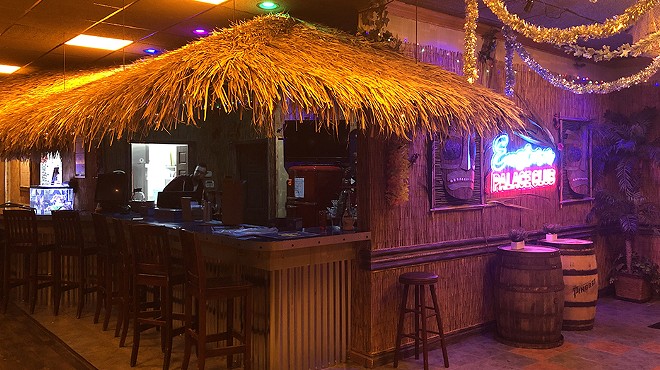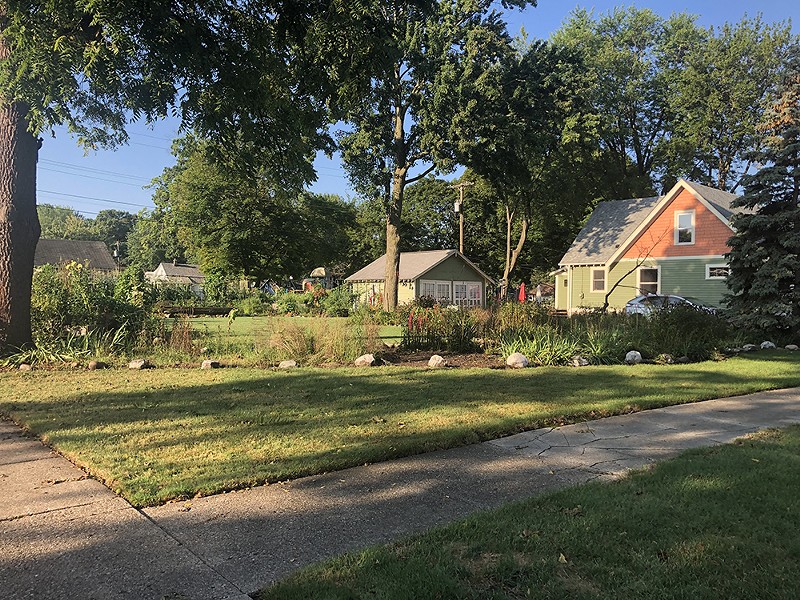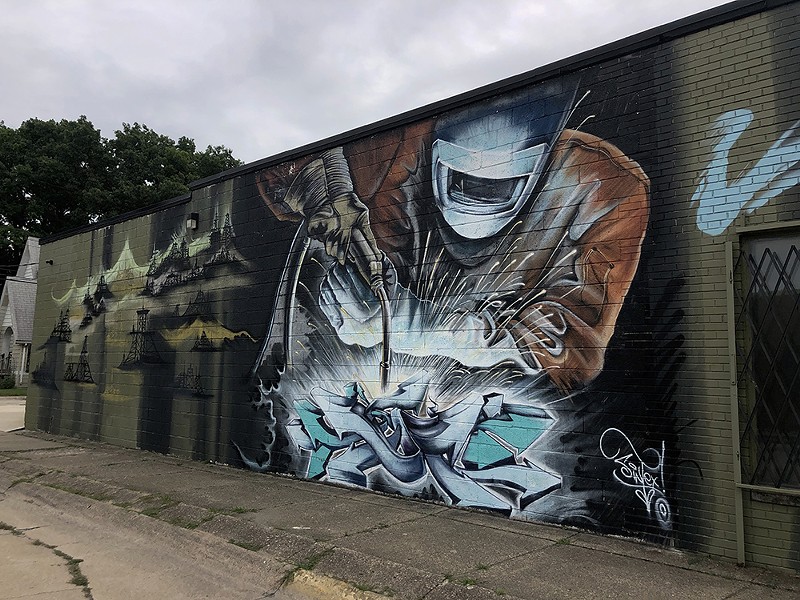In 2020, two years after graduating from college, Brandon Gaines was bored with his hometown of Rochester Hills and began searching for a new place to live with his boyfriend.
They looked at all the usual places for young professionals in metro Detroit — Ferndale, Royal Oak, Midtown. Each had an eclectic mix of restaurants, bars, and coffee shops within walking distance of apartments.
But all were well beyond their budget.
Then a friend recommended Hazel Park.
“Hazel Park? What’s in Hazel Park?” he recalls responding.
Turns out, there’s a lot going on these days in Hazel Park, a 2.8-square-mile city that is experiencing a renaissance.
The couple found a two-bedroom apartment in Hazel Park for $850 a month, just blocks from a stretch of John R Road that is undergoing a transformation.
“Moving here was one of the best decisions I’ve ever made,” Gaines said. “The community has accepted us, and I feel more at home here than I ever did in Rochester Hills. Everything I need is right here.”
A longtime blue-collar suburb bordering Detroit, Ferndale, Madison Heights, and Warren, Hazel Park was known for decades for its horse racing, dive bars, and greasy spoons.
Today, it’s home to a sizable LGBTQ community, two high-end restaurants, new condos, eight recreational cannabis dispensaries (plus the state’s first marijuana consumption lounge), and an industrial park that has embraced the new green economy.
Young professionals are drawn to the relatively inexpensive houses, hip new businesses, and the city’s close proximity to I-696 and I-75.
“The most important thing that happened is that everyone found out we’re open for business,” Hazel Park City Manager Ed Klobucher tells Metro Times. “We’ve been very interested in bringing newer, updated businesses to Hazel Park. It was a conscious decision to attract some destination businesses.”
Politically engaged new residents helped elect progressive city officials, and two of the five city council members are LGBTQ.
In April 2021, the council passed a human rights ordinance to protect LGBTQ residents from discrimination, and in February 2022, the city banned conversion therapy, the widely discredited practice that aims to “cure” LGBTQ people. A month later Hazel Park joined the psychedelic revolution by becoming the third city in the state to decriminalize psilocybin mushrooms and other entheogenic plants, following Ann Arbor and Detroit.
The votes were unanimous.
At 33, Luke Londo is the youngest city council member. He was elected to a four-year term in November.
“Politics at this level is about community, not ideology,” Londo tells Metro Times. “We sit down at the end of the day and talk about being good stewards of the residents. The decisions are simple. These are the things our constituents want.”
Hip, high-end eateries
In September 2015, renowned chef James Rigato helped set Hazel Park on a new path when he opened his restaurant, Mabel Gray, inside an abandoned diner on John R just south of Woodward Heights. Across the street was a blighted, long-vacant CVS pharmacy that is now being converted into a four-story building with apartments and retail stores.
With exposed plaster walls, vintage tableware, and an open kitchen, the snug, 1,600-square-foot restaurant features a seasonal, constantly changing menu of fresh, local, and made-from-scratch ingredients. Mabel Gray quickly became a celebrated restaurant that draws people from all over Southeast Michigan, providing diners a glimpse of a city on the rise. In 2017, Mabel Gray won the coveted Detroit Free Press restaurant of the year and was featured in The New York Times.
Rigato bought a house in Hazel Park and is now one of the city’s biggest boosters.
“I love Hazel Park,” Rigato tells Metro Times. “My goal was to open a funky space and have creative freedom. Sixteen hundred square feet allowed that. The Southeast Michigan community has embraced me.”
Rigato knows it was an unorthodox decision to open up in Hazel Park, but as someone who spent time in the city in his young 20s, he saw the potential.
“Ferndale and Royal Oak are the darlings of the area, but to me, Hazel Park has always been the overlooked, funky cousin,” he says.
Mabel Gray has 22 employees, and most are full-time.
When Mabel Gray opened, an ice cream stand, Doug’s Delight, stood abandoned two blocks north of the restaurant. A staple in the community for nearly 50 years, Doug’s Delight closed when the owner died in August 2014.
Then Rigato purchased the building, pouring about $400,000 into it.
“It was a terrible idea,” Rigato half-jokes, “but it was good for the city. I’m playing the long game. I want it to be there in 30 years.”
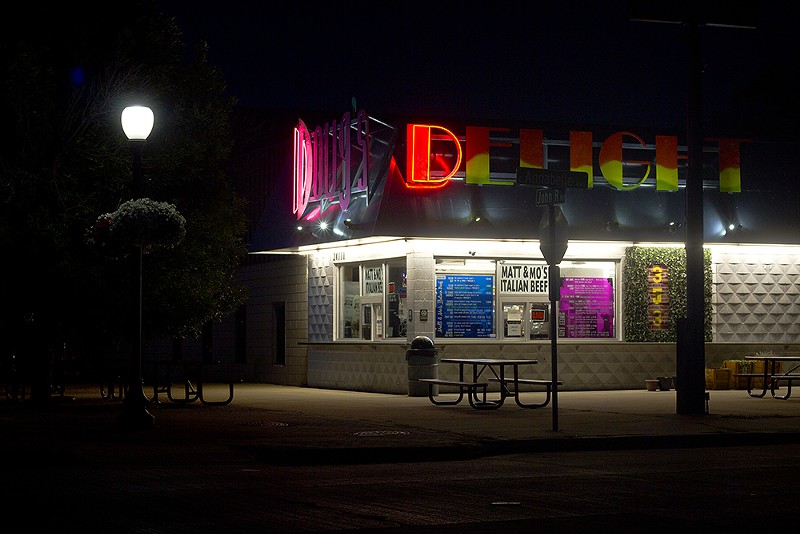
In April 2018, Doug’s Delight reopened with ice cream, milkshakes, slushies, brownies, cookies, and sundaes. Two years later, Chicago couple Matt and Mo Marzullo took over and set up a savory eatery inside called Matt and Mo’s Italian Beef, which sells authentic Chicago-style Italian beef sandwiches (currently trendy thanks to the FX hit TV series The Bear), as well as hot dogs, toasted ravioli, cheddar fries, and pizza puffs. They still offer ice cream, too, including flavors like key lime pie, Midnight Train to Traverse, Blue Moon, Detroit Grand Slam, and cookies n’ cream.
Rigato, like many entrepreneurs who spoke with Metro Times, credits Hazel Park officials for creating a business-friendly environment.
“The city has been incredible to work with,” he says. “They welcomed me with open arms. Those guys sat down at the table and said, ‘How can we help?’ There was no delay. There were no zoning arguments.”
Next door to Mabel Gray are two ephemeral restaurants with rotating chefs under one roof. In a nondescript building on John R near Woodward Heights, Frame and FRAMEbar have become destination dining spaces.
Opened by Cari and Joe Vaughn in 2017, Frame is a restaurant within a restaurant, accessed through a false door near the bathrooms of FRAMEbar.
With exposed brick and ethereal lighting, the hidden dining space offers something new every weekend, from modern Moroccan cuisine to a traditional Mexican dinner, all cooked by celebrated chefs.
Frame is also used for workshops to teach about wines, breads, crêpes, caviar, sourdough, ceramics, and even astrology.
In front of the building is FRAMEbar, a restaurant with a full bar and outdoor patio. The menu rotates every month with a new chef and is paired with cocktails and music. This month features sushi chef Shinya Hirakawa.
Behind FRAMEBar is a tented backlot with a bar, a shipping container kitchen with a wood- and gas-fired oven, and plenty of space to hang out to watch films and comedians.
The restaurant owners also purchased a home across the street, which it uses to house visiting pop-up chefs from out of town.
“Sometimes we tell people we’re in Hazel Park, and they say, ‘Where?’” Mark Kurlyandchik, editorial director of Frame, tells Metro Times. “To us, this feels like the center of the universe. We’re exposing people from all over the region to Hazel Park.”
With Frame and Mabel Gray on one block, and a planned mixed-use development across the street, city officials have envisioned the beginning of a downtown.
“We would like more on the John R strip,” Kurlyandchik says. “There are a lot of millennials moving in with a lot of new energy. We want to bring some diversity to Hazel Park and make it a vibrant downtown.”
Also along John R, city officials are planning to transform a vacant lot into what they’re calling, “Pop Up Hazel Park,” a space for pop-up businesses, food trucks, and a farmer’s market. The project is funded by a $450,000 grant from U.S. Rep. Andy Levin.
Councilman Londo says it’s only a matter of time before a downtown takes shape, and points to Nine Mile Road in Ferndale as an example of how a small city can create a walkable destination with bars, restaurants, coffee shops, and retail stores.
“Hazel Park is going to have a downtown,” Londo tells Metro Times. “I’m really hoping that in five years or so that John R is going to be similar to what you see in Ferndale, but we’re trying very deliberately to curate our own sense of identity. The goal of Hazel Park is to be a one-stop destination.”
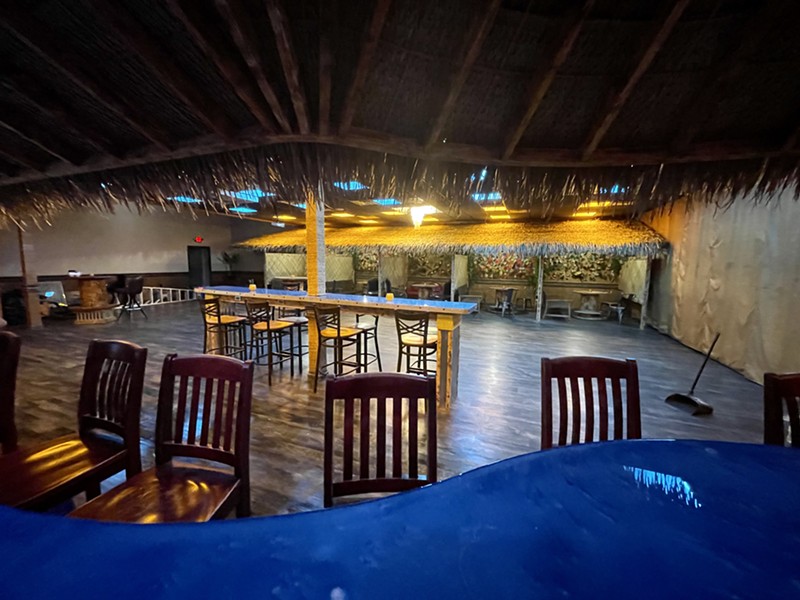
Welcome to the South End
In Hazel Park, John R stretches from Eight Mile to 10 Mile. The area south of Nine Mile has been dubbed the South End, where vacant buildings still dot the landscape. Only one restaurant, Pizza Connection, is open in the South End, even though John R is surrounded by residential neighborhoods.
But city officials and entrepreneurs are beginning to transform the landscape, and they believe it’s going to be Hazel Park’s next bright spot.
Seeing the potential, three young business partners — Mike Pierce, Dustin Leslie, and Adam O’Connor — are completely revamping the Eastern Palace Club, a former Middle Eastern restaurant that closed in September 2021, located on John R between W. Madge and W. Evelyn avenues.
If all goes as planned, the Key West-themed Eastern Palace Club will open in September or October, with a tiki-themed bar and dining area with plenty of space to share a craft cocktail or mocktail with friends.
Channeling tropical paradise vibes, the Eastern Palace Club will feature beach-inspired food from the people behind the Smoked Lotus BBQ pop-up. The menu is expected to include broasted chicken, ribs, barbecue rice rolls, and briskets.
“Imagine being on a vacation,” Pierce tells Metro Times. “As soon as you walk in, you are transported to this beach-side dive bar. It’s really mind-blowing. You feel like you are transported somewhere warm and somewhere not necessarily in Michigan.”
Pierce, who bought a house in Hazel Park about five years ago, says there’s “huge potential” in the South End.
“It’s a cool renaissance, and it’s just the beginning. In the next five years, Hazel Park is going to explode.”
tweet this
“It’s just the perfect time and place,” Pierce says. “I’ve seen what’s going on. With the city continuing to become an inclusive, up-and-coming area, we’re seeing this community go through a full shift where we’re getting a ton of artists and musicians. It’s a cool renaissance, and it’s just the beginning. In the next five years, Hazel Park is going to explode.”
Three blocks north on John R is Dairy Park, an abandoned, barn-shaped ice cream shop that had been a staple in the community since 1954.
After several recent owners failed to keep the Dairy Park afloat, Mike Piziali is renting the unique building and offering a new menu: shredded meat sandwiches, burritos, and skillets with his signature crispy seasoned hash browns sold out of his popular food truck Shredderz. He’ll also serve ice cream, grilled cheeses, chorizo burritos, and pulled pork.
The 32-year-old hopes to open in September, but customers may have to wait until next spring or summer.
“Hazel Park is an up-and-coming place,” Piziali tells Metro Times. “Ferndale and the surrounding cities are noticing what Hazel Park has to offer. There are a lot of great properties, and people want it to be better than what it has been.”
Piziali doesn’t expect the transformation to happen overnight, but he says each new business is lifting up Hazel Park.
“Developing piece by piece is going to get where it needs to be,” he says.
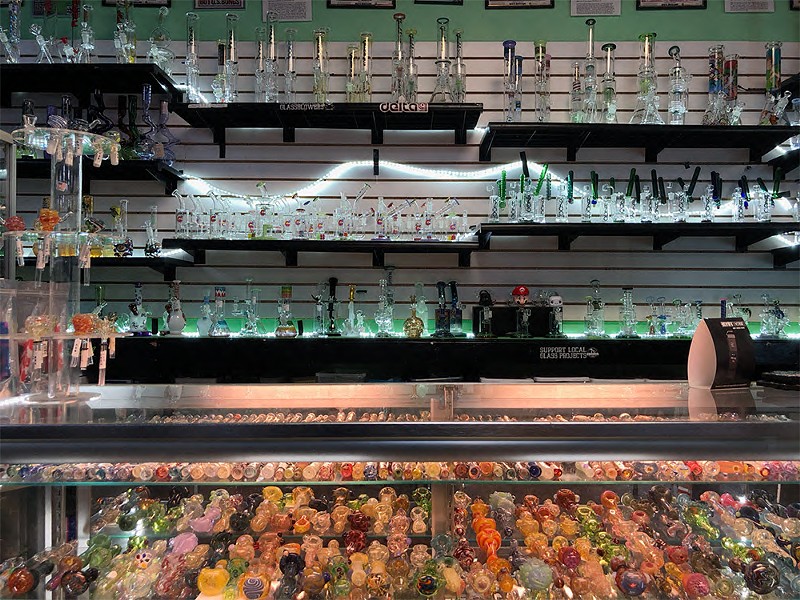
The green rush
With all of the new developments in Hazel Park, nothing has been quite as impactful and noticeable as the legalization of recreational marijuana. The city now has eight adult-use dispensaries, more than anywhere else in metro Detroit, along with more than 30 other recreational and medical marijuana businesses — including the state’s first cannabis consumption lounge, Hot Box Social, just two blocks south of Mabel Gray and Frame on John R.
Unlike many communities in Michigan, Hazel Park embraced cannabis legalization, providing a business-friendly environment that is paying back in dividends.
Most of the new cannabusinesses occupy previously abandoned buildings, and all are contributing to the city’s cash-strapped budget.
The excise tax on recreational marijuana alone brought in more than $300,000 in the past year, says Hazel Park Councilman Mike McFall.
“We are using the money to cover pensions,” McFall tells Metro Times. “We kicked the bucket down the road, and now we have to pay for it. If we didn’t have the dispensary money coming in, I honestly don’t know what we would do.”
Since Detroit and many other communities in the metro area don’t yet allow recreational marijuana dispensaries within their borders, thousands of people are visiting Hazel Park every day to frequent the cannabusinesses.
“Marijuana has really helped change the perceptions of our city,” McFall says. “People who come here for marijuana may not have stepped in our community otherwise. People are coming and eating and doing more. They are exploring more, and understanding what’s going on in the city.”
In addition, the cannabusinesses have provided hundreds of good-paying jobs with benefits, and many of those employees live in Hazel Park, where they spend a lot of their money.
“These are good jobs that people can support themselves on,” Klobucher says.
The cannabusinesses also are giving back in charitable ways, providing funding for events and community organizations. The Breeze dispensary on John R, for example, contributes to Hazel Park Promise, an initiative to provide scholarships for high school graduates to attend college.
“They have all been amazingly good corporate citizens, and they are always willing to donate money and time and resources to community events,” Klobucher says.
“The consensus in Hazel Park not that long ago was that marijuana was something bad. The city took a chance and embraced it. The war on drugs is a lost cause. People are over it.”
tweet this
Hazel Park has a long history with marijuana. For 49 years, B.D.T. Smoke Shops has been selling cannabis paraphernalia and other marijuana-related products, long before the proliferation of head shops.
The indisputable anchor of the city’s South End, B.D.T., has drawn generations of stoners to Hazel Park. For many young people, it’s a rite of passage.
The owner, Curt Goure, is one of the city’s biggest boosters. He recently strung up 28 strands of LED lights outside his shop over John R with a banner that reads, “Welcome to Hazel Park’s South End.”
Despite the acceptance of marijuana today, Goure says attitudes in the city were far more different even a decade ago.
“We were the black sheep of the city,” Goure tells Metro Times. “The consensus in Hazel Park not that long ago was that marijuana was something bad. The city took a chance and embraced it. The war on drugs is a lost cause. People are over it.”
Goure began to notice attitudes were shifting when the city gave his friend, the famous stoner and marijuana advocate Tommy Chong, a key to the city in April 2015 when he stopped by B.D.T. Smoke Shops ahead of Ann Arbor’s Hash Bash.
A year earlier, Hazel Park residents voted to decriminalize marijuana in the city.
In November 2018, when recreational marijuana was legalized statewide at the ballot box, more than 75% of Hazel Park residents voted in favor of the initiative.
For B.D.T. Smoke Shops, marijuana is a three-generation business. In a few months, Goure’s daughter Dana Elgie plans to open a Class A microbusiness dispensary and cultivation establishment, called Hive, next door to B.D.T.’s. The concept is to grow small amounts of high-quality cannabis.
“We’re trying to stay away from the Walmart weed and following parallels to the craft beer industry,” Goure says.
The new businesses will help bolster the South End as a “destination location,” he says.
Goure would like to see a financial institution invest in the area, and for a major franchise and brewery to set up shop in the South End.
“We are just thrilled,” Goure says. “We’ve been the stepchild of Hazel Park, and we have not received that much attention. I think this is the future. We are dressing up this whole South End and making it festive.”
Good deals on houses
One of the major draws to Hazel Park is the relatively inexpensive houses. Of the 10 cities in southeastern Oakland County, Hazel Park has had the lowest median sales price of a home in years, according to real estate records.
The median sale price for a home in Hazel Park was $160,000 in June 2022. That’s compared to:
• $300,000 in Berkley
• $580,000 in Beverly Hills
• $460,000 in Birmingham
• $250,000 in Clawson
• $250,000 in Ferndale
• $485,000 in Huntington Woods
• $243,000 in Oak Park
• $510,000 in Pleasant Ridge
• $325,000 in Royal Oak
The value of homes also is rising faster than most of the neighboring cities. The median sale price of a home in Hazel Park rose 39.1% in the past three years, more than all of the other southeastern Oakland County cities, with the exception of Beverly Hills (39.4%) and Oak Park (51.9%).
Resident Carly Peil recently paid $150,000 for her 1,500-square-foot house with four bedrooms and two baths.
“You really can’t find that anywhere,” the 26-year-old tells Metro Times.
And she would know. She’s now a real estate agent and is finding that homebuyers are drawn to Hazel Park for the relatively inexpensive prices.
“It’s a great time to buy, even in the craziness of the housing market,” Peil says. “It’s still affordable, especially with all of the growth over the past four or five years in Hazel Park, and I think we’re going to continue on that trajectory.”
Peil is a relative newcomer to metro Detroit, and happenstance brought her to Hazel Park. When she moved from Bay City to the metro area to be closer to her boyfriend, her friends were moving out of a rental in Hazel Park. She and her boyfriend moved in, and grew to appreciate the city.
“Since being here for three years, I have really grown to like it. It’s the perfect location, and we’re only 12 minutes from downtown,” Peil says. “We have great neighbors. We’ve never felt unsafe. Everyone is really nice. I have been pleasantly surprised by how it feels to live here.”
Peil and her boyfriend frequent FRAMEBar, Mabel Gray, Doug’s Delight, the dispensaries, and Kozy Lounge, a popular dive bar.
As a Realtor, Peil gets a lot of requests for houses in Ferndale, Royal Oak, and Madison Heights. She always encourages prospective buyers to check out Hazel Park.
“A lot of my clients who aren’t looking at Hazel Park end up loving the feel of the neighborhood, the prices, and the homes,” she says. “Hazel Park is still under the radar. It’s becoming more popular. With the affordability and all these new businesses, people are pleasantly surprised when they give Hazel Park a chance.”
Peil lives a block-and-a-half from Ferndale, where the prices for houses are much higher.
“I have people looking in this neighborhood (Ford Heights), and they look at both places, and the one across the street in Ferndale is nice, but smaller and less of everything, and is like $80,000 to $100,000 more. People were offering $30,000 to $40,000 above asking price to live in Ferndale.”
For Maria Nuccilli, a librarian at Wayne State University and drummer in the band Deadbeat Beat, the appeal of Hazel Park isn’t the new businesses. Originally from Grosse Pointe, she and her husband Neil rented in Ferndale, Hamtramck, Pleasant Ridge, and Hazel Park. After renting in Hazel Park for eight years, they were won over by the friendliness of the city, and bought their home in August 2020.
“I like that the city and the neighbors aren’t pretentious,” she says. “We have great neighbors. They look out for each other. Once we moved to this side of town, we found our people.”
From horses to green energy
For decades, the blue-collar city was known for the Hazel Park Raceway, a horse-racing track built atop a garbage dump that took up 10% of the city’s geographic area. Thousands of people used to pack into the grandstands to watch thoroughbred racing.
In 2018, the track closed for good, ending a nearly 70-year era.
For a city that relied on tax revenues from the track, it could have been a nightmare to lose the raceway. But Hazel Park officials wasted no time finding a new purpose for the land.
With the help of Ashley Capitol, the site is now used by businesses that help build a cleaner, greener economy. One of the companies is Exlterra, a sustainable technological solutions firm from Switzerland that moved its North American headquarters to Hazel Park. The company has a technology that helps clean up polluted sites without using chemical products or soil removal.
“They are a modern-day Leonardo da Vinci with their ability to solve problems that people think are unsolvable,” Klobucher says. “We’re really proud of the international work they are doing.”
With a population of about 16,500 residents, Hazel Park is still a long way from its peak of 25,631 people in 1960.
But city officials and residents seem both vigilant and patient about a full revival.
To make more headway, Rigato says the city must be tougher on owners of abandoned buildings. He says some landlords are sitting on properties, waiting for more money.
“All of the great things about Hazel Park does not mean it’s a gold rush,” Rigato says. “Affordable prices is why we’re here. If you want Hazel Park to be cool, stop being a slumlord. If you’re sitting on a piece of shit building and asking 30 bucks per square foot, you should reconsider your contributions to Hazel Park.”
With all the new growth, Nuccilli says Hazel Park isn’t just about the newcomers.
“I just hope the homeowners who have been here for a long time get to reap some kind of reward for being interested in this little town,” Nuccilli says. “I want to see the city grow and flourish for everyone.”
Stay connected with Detroit Metro Times. Subscribe to our newsletters, and follow us on Google News, Apple News, Twitter, Facebook, Instagram, Reddit, or TikTok.


